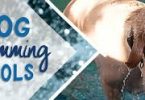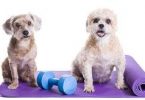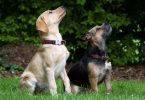The first 15 weeks of your puppy’s life are very important. That’s when he or she takes on life and learns what is safe in his world and what is not. Confidence at this early age can last forever, creating a well tempered, emotionally flexible adult dog. Fears developed at this stage can also last a long time and create serious behavioral issues.
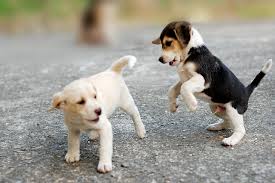
Introduce your puppy to the world safely and joyfully. Associate every new experience with something wonderful, like treats, play or your joyful voice.
1.) Introduce your puppy to different kinds of people. Seek out different genders, looks, sizes, skin tones, voice qualities, hair styles. People with hats, glasses, canes and wheelchairs.
2.) Show your puppy things in your house that make noise. Vacumn cleaner, blender, refrigerator, washer, dryer, doorbell, smoke alarm.
3.) Walk your puppy on different surfaces. Glass, tile, rocks, grass, flat plastic garbage bag, wet surfaces.
4.) Feed your puppy by hand and take way his food bowl while he is eating.
5.) Train your puppy 18 times per week. Short sessions 2-3 times per day.
6.) Offer your puppy different chew toys with varying texture and consistency.
7.) Trade toys with your puppy. While she’s playing with one, offer a better one.
8.) Introduce your puppy to other puppies, small children and well mannered adult dogs.
9.) Take your puppy to different places in the car. Pet store, park, Loews, parking lots, baseball games.
10.) Show your puppy fun people toys like bikes, skateboards, rollerblades, roller skates, tennis rackets, rakes, shovels, brooms, lawn mowers, leaf blowers.
11.) Let your puppy sleep near you or in your bedroom. It strengthens the social bond.
12.) Handle your puppies ears, feet, mouth and whole body. Grab ahold of his dog collar.
13.) Get your puppy used to noises. Walk on a busy street on leash. Play with noisy garbage cans. Toss a ball indoors during a thunderstorm. Be creative.
14.) Introduce your puppy to visitors. Mailman, UPS and Fedex man, garbage men, repairmen.
15.) Rehearse visits to the groomer, vet and boarding kennel.
The more you and other people handle your puppy, the easier it will be for him to accept it in the future as an adult. These are some great handling tips to practice daily with your new puppy.
 Mouth/Teeth-Rub all gum and tooth surfaces feeling for lumps or “hot areas”. This gets your puppy used to mouth examinations as well as teeth brushing. Run your fingers along their teeth and gums. As your dog gets older, you will need to brush his teeth a minimum of 3 times per week to prevent plaque and tartar from accumulating.
Mouth/Teeth-Rub all gum and tooth surfaces feeling for lumps or “hot areas”. This gets your puppy used to mouth examinations as well as teeth brushing. Run your fingers along their teeth and gums. As your dog gets older, you will need to brush his teeth a minimum of 3 times per week to prevent plaque and tartar from accumulating.
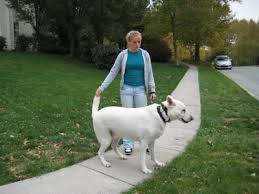 Tail-Gently examine the tail with light pressure from the base all the way to the tip. Tug gently during the examination, gradually working up to a reasonable amount of pressure. Sometimes in life your dogs tail will get pulled. This helps desensitize your puppy so that he will take exception to the accidental pull later in life, especially if you have young children in the family. It also accustoms owner and puppy to examine this much neglected appendage. It helps with getting the puppy used to having his tail brushed and lifted up to remove debris from the butt area and for anal gland expression if needed.
Tail-Gently examine the tail with light pressure from the base all the way to the tip. Tug gently during the examination, gradually working up to a reasonable amount of pressure. Sometimes in life your dogs tail will get pulled. This helps desensitize your puppy so that he will take exception to the accidental pull later in life, especially if you have young children in the family. It also accustoms owner and puppy to examine this much neglected appendage. It helps with getting the puppy used to having his tail brushed and lifted up to remove debris from the butt area and for anal gland expression if needed.
 Heartbeat-Cup your hand over the apex of your puppies chest. In larger dogs, over the side is better. Feel the strength and speed of the heartbeat. Being able to find the heartbeat may sound silly, but it is better to get used to looking for and finding it now than in an emergency. Talk to your vet about what is normal for your puppies size and breed.
Heartbeat-Cup your hand over the apex of your puppies chest. In larger dogs, over the side is better. Feel the strength and speed of the heartbeat. Being able to find the heartbeat may sound silly, but it is better to get used to looking for and finding it now than in an emergency. Talk to your vet about what is normal for your puppies size and breed.
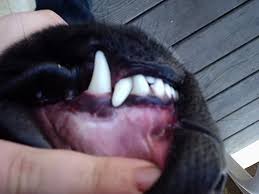 Capillary Refill Reflex-Lift the flew on either side of the mouth, exposing the gum above the teeth. Press with the pad of your finger for one second and release. Capillary refill can be an indication of shock after a physical trauma. Check the color of the gums. After pressure, note the time it takes for the gums to return to the original color. Gray gums, or lack of refill after pressing indicate a serious medical condition and immediate veterinary attention is necessary.
Capillary Refill Reflex-Lift the flew on either side of the mouth, exposing the gum above the teeth. Press with the pad of your finger for one second and release. Capillary refill can be an indication of shock after a physical trauma. Check the color of the gums. After pressure, note the time it takes for the gums to return to the original color. Gray gums, or lack of refill after pressing indicate a serious medical condition and immediate veterinary attention is necessary.
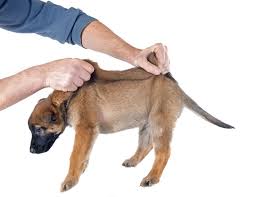 Dehydration-Pinch and gently lift up the skin either between the head and ear or on the scruff, then release. If the skin stays tented, this is an indication of dehydration. Slow return is also an indication. Use this vital sign if the puppy has been overexposed in the heat or has diarrhea or vomiting. Report any signs of dehydration to your vet.
Dehydration-Pinch and gently lift up the skin either between the head and ear or on the scruff, then release. If the skin stays tented, this is an indication of dehydration. Slow return is also an indication. Use this vital sign if the puppy has been overexposed in the heat or has diarrhea or vomiting. Report any signs of dehydration to your vet.
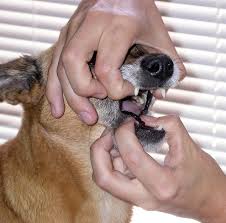 Force Treat-Open the mouth by pinching the flews on both sides against the teeth until the teeth part. Lift the upper jaw upwards as if to remove a forbidden object or to administer medication. Drop the treat onto the tongue in the front portion of the mouth. Do not tip the head backwards. This allows the puppy to become accustomed to a forcible opening without other unpleasant or intimidating factors. The treat gives your puppy a positive initial experience to the forced open instead of a negative that would accompany the removal of a stolen object or the negative receiving of a pill.
Force Treat-Open the mouth by pinching the flews on both sides against the teeth until the teeth part. Lift the upper jaw upwards as if to remove a forbidden object or to administer medication. Drop the treat onto the tongue in the front portion of the mouth. Do not tip the head backwards. This allows the puppy to become accustomed to a forcible opening without other unpleasant or intimidating factors. The treat gives your puppy a positive initial experience to the forced open instead of a negative that would accompany the removal of a stolen object or the negative receiving of a pill.
 Gentle Head Pat-Gently pat the puppy on top of the head. After a couple of pats, rub the puppy in their favorite place to praise. Repeat procedure, patting alittle harder. Pats on the top of the head can be considered to be a dominant gesture by dogs. Unfortunately, this is one of the most likely motions a toddler will make. Getting the puppy used to this seemingly unpleasant gesture now will help desensitize the puppy and they may even learn to tolerate or even like it.
Gentle Head Pat-Gently pat the puppy on top of the head. After a couple of pats, rub the puppy in their favorite place to praise. Repeat procedure, patting alittle harder. Pats on the top of the head can be considered to be a dominant gesture by dogs. Unfortunately, this is one of the most likely motions a toddler will make. Getting the puppy used to this seemingly unpleasant gesture now will help desensitize the puppy and they may even learn to tolerate or even like it.
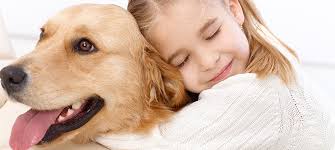 Gentle Hug-Gently pull the puppy into your lap and offer a very light hug. Release and praise, then repeat. As primates we like to hug, but our canine friends do not. Hugs can be very confusing for puppies. However, this is one of the most likely actions your puppy may experience from a younger child, we need to help them understand that hugs can be pleasurable. Getting your puppy used to this gesture may make them less likely to take exception to it and possibly respond out of fear.
Gentle Hug-Gently pull the puppy into your lap and offer a very light hug. Release and praise, then repeat. As primates we like to hug, but our canine friends do not. Hugs can be very confusing for puppies. However, this is one of the most likely actions your puppy may experience from a younger child, we need to help them understand that hugs can be pleasurable. Getting your puppy used to this gesture may make them less likely to take exception to it and possibly respond out of fear.
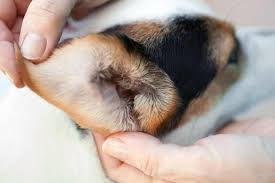 Eyes and Nose-This is a visual examination. Look into your puppies nose. Gently clear away any discharge from the eyes and nose with a moist washcloth. Look into your puppies eyes. Puppies should not have nasal discharge. Eyes should be clear, shiny and bright. If your puppy has nasal discharge, cloudiness or a diffused appearance in either or both eyes, contact your veterinarian for an examination.
Eyes and Nose-This is a visual examination. Look into your puppies nose. Gently clear away any discharge from the eyes and nose with a moist washcloth. Look into your puppies eyes. Puppies should not have nasal discharge. Eyes should be clear, shiny and bright. If your puppy has nasal discharge, cloudiness or a diffused appearance in either or both eyes, contact your veterinarian for an examination.
North Coast Dogs



